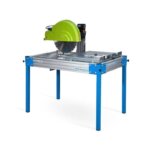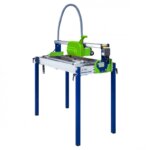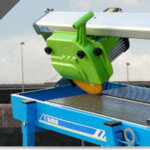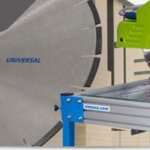Some common sense safety guidelines, like wearing appropriate clothing and keeping your hand out of the path of the blade, apply to all saws. They are also tips that you have likely heard over and over again, and ones that might have even occurred to you on your own. But masonry saws are quite different from other types of saws, and not all masonry saws are the same. That’s why this post will focus on some of the more advanced safety guidelines for different types of masonry saws and applications: wet cutting with a water tank, wet cutting with a masonry table saw with built-in water pan, and dry cutting.
Contents
Masonry table saw safety: wet cutting with a water tank
In terms of safety, using a masonry table saw with a water tank or other external water supply is mostly a no-brainer. There are no special precautions that need to be taken with this type of masonry saw application. Just follow the tried-and-true basic safety tips: wear appropriate clothing and shoes, safety goggles or face shield, head and ear protection; ensure that all parts of the machine are in good condition before cutting; double check that your water pump is working and that water is flowing freely over both sides of the blade.
If you hear strange noises or feel unusual vibrations, power the masonry table saw off and investigate what the problem could be. Finally, don’t try to make the saw cut faster by putting more pressure on the blade or the stone you are cutting—all this will accomplish is creating a safety hazard while reducing the useful life of your diamond blade.
Masonry table saw safety: wet cutting with a built-in water pan
Wet cutting on a masonry table saw with an integrated water pan or tray is essentially the same as using a machine with a tank or external water hookup, but there is one very important difference in terms of user safety. The difference is that the water being used to cool the blade is coming from the same tray where most of the mud and debris from cutting ends up, which means there is a risk of the water pump getting a blockage.
For safety purposes, it is important to keep an eye on your pump and water flow in this type of masonry table saw setup. A blockage in the pump can be a safety hazard in and of itself, while restricted water flow can cause the diamond blade on your masonry saw to overheat dangerously during cutting.
Masonry table saw safety: dry cutting
Practically any masonry table saw can be used for dry cutting, and it may seem as simple as disconnecting the water pump and removing the water curtain, as applicable. But there are a few other things you need to keep in mind in order to dry cut safely with your masonry saw. First, you need to use a diamond blade that is specifically labeled for dry cutting. Second, because there is no water to cut down on dust, you need to wear a respirator mask and cut in an open, well-ventilated area. Finally, you need to make short, shallow cuts and give the blade time to cool down before making your next cut.





